

Coaching digital : la prescription et le locus de contrôle. International Workshop on the Web of Things (WoT) The Internet of Things has become a well-known brand for a set of research issues in the pervasive and ubiquitous computing communities.
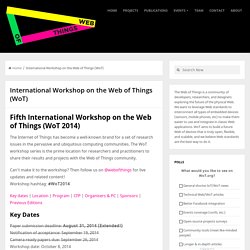
The WoT workshop series is the prime location for researchers and practitioners to share their results and projects with the Web of Things community. Can’t make it to the workshop? Then follow us on @webofthings for live updates and related content! Workshop hashtag: #WoT2014. Web of Things. Internet of Things. The Internet of Things (IoT) is the network of physical objects or "things" embedded with electronics, software, sensors and connectivity to enable it to achieve greater value and service by exchanging data with the manufacturer, operator and/or other connected devices.
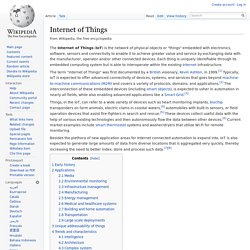
Each thing is uniquely identifiable through its embedded computing system but is able to interoperate within the existing Internet infrastructure. The term “Internet of Things” was first documented by a British visionary, Kevin Ashton, in 1999.[1] Typically, IoT is expected to offer advanced connectivity of devices, systems, and services that goes beyond machine-to-machine communications (M2M) and covers a variety of protocols, domains, and applications.[2] The interconnection of these embedded devices (including smart objects), is expected to usher in automation in nearly all fields, while also enabling advanced applications like a Smart Grid.[3] Early history[edit] In its original interpretation,[when?]
Media[edit] Web of Things. The Web of Things (or WoT) is a concept and a set of blueprints to make every-day physical objects first class citizens of the World Wide Web by giving them an API, thus greatly facilitating the creation of their virtual profiles as well as their integration and reuse in all kinds of applications.
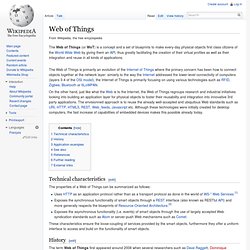
The Web of Things is primarily an evolution of the Internet of Things where the primary concern has been how to connect objects together at the network layer: simiarly to the way the Internet addressed the lower-level connectivity of computers (layers 3-4 of the OSI model), the Internet of Things is primarily focusing on using various technologies such as RFID, Zigbee, Bluetooth or 6LoWPAN.
On the other hand, just like what the Web is to the Internet, the Web of Things regroups research and industrial initiatives looking into building an application layer for physical objects to foster their reusability and integration into innovative 3rd party applications. Technical characteristics[edit] This Android Wear App Lets You Control Your PC With Your Watch. If you’ve ever felt too lazy to reach for the mouse and keyboard, you can now use an Android Wear smartwatch to control your PC instead.
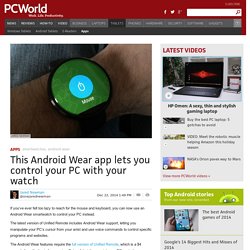
The latest version of Unified Remote includes Android Wear support, letting you manipulate your PC’s cursor from your wrist and use voice commands to control specific programs and websites. The Android Wear features require the full version of Unified Remote, which is a $4 upgrade from the basic free version. But as futuristic as wrist-worn PC controls seem, keep in mind that the software still needs some serious polish. Why this matters: Jokes about laziness aside, controlling a computer by smartwatch could be make a lot of sense for home theater PC setups, where touch-based smartphone controls are already quite useful. Unified Remote is the first app to give it a try. Once you install Unified Remote on your phone, a persistent notification appears on your watch. Home English - Intel IT Center Connect. Objets connectés. Accueil / Open Wide. Google envisage d'attribuer une URL pour chaque objet connecté.
Les Objets Connectés. Physical Web, l’open-source pour simplifier l’internet des objets. On le sait, le marché les objets connectés est le secteur de demain qui va littéralement explosé !
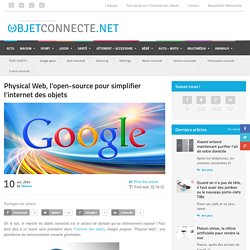
Pour faire face à ce boum sans précédent dans l’internet des objets, Google propose “Physical Web”, une plateforme de communication nouvelle génération. Toutes les sociétés proposent leur objet connecté et tout le monde finira par avoir dans sa maison, sa voiture ou à son poignet un de ses nouveau objet connecté à votre smartphone. Pour vous simplifier la vie, Google voudrait attribuer une URL unique à chaque objet et éviter la multiplication des applications car à se rythme de croissance, il va être de plus en plus difficile de s’y retrouver.
Un framework Open Source pour l'« Internet des objets » Le framework d'AllSeen Alliance peut couper le chauffage d’une habitation via un système domotique.
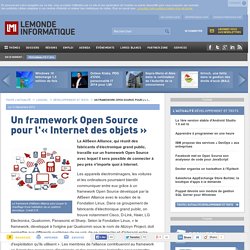
Crédit D.R. La AllSeen Alliance, qui réunit des fabricants d'électronique grand public, travaille sur un framework Open Source avec lequel il sera possible de connecter à peu près n'importe quoi à Internet. Les appareils électroménagers, les voitures et les ordinateurs pourraient bientôt communiquer entre eux grâce à un framework Open Source développé par la AllSeen Alliance avec le soutien de la Fondation Linux. Dans ce groupement de fabricants d'électronique grand public, on trouve notamment Cisco, D-Link, Haier, LG Electronics, Qualcomm, Panasonic et Sharp. Selon la Fondation Linux, « le framework, développé à l'origine par Qualcomm sous le nom de AllJoyn Project, doit permettre aux différents systèmes de se voir, de se connecter et d'interagir entre eux de façon transparente, indépendamment du fabricant ou du système d'exploitation qu'ils utilisent ». Objets connectés & Innovation Hardware.
RIOT - The friendly Operating System for the Internet of Things. RIOT : un OS open source pour l’Internet des Objets. Salon CeBIT 2014 © Inria / Photo G.
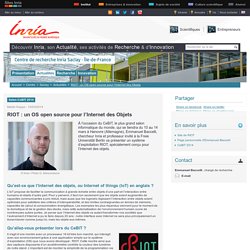
Maisonneuve.